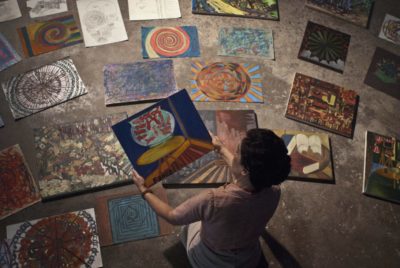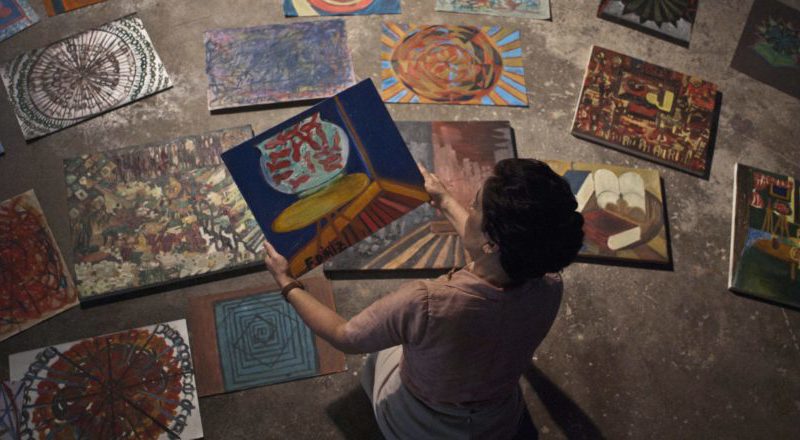INTERVIEW: Roberto Berliner heads into ‘Heart of Madness’ for new biopic

NISE: The Heart of Madness tells the true story of the trailblazing doctor, Nise da Silveira, played by Gloria Pires. She worked at a psychiatric hospital on the outskirts of Rio de Janeiro and refused to utilize electroshock therapy for her schizophrenic patients. Instead, she began an occupational therapy treatment that included painting, dogs and love.
The doctor was ridiculed for her approach with the patients, but history has proved that her work was tremendously impactful, both in the art world and the medical world.
NISE, which recently opened in New York City and Chicago, is the work of director Roberto Berliner. Recently, Hollywood Soapbox exchanged emails with the filmmaker about his portrait of a doctor wanting to bring about real change. Questions and answers have been slightly edited for style.
How did you first hear about this story?
The first time I saw Dr. Nise was in the 1980s at Circo Voador, a cultural center in Rio de Janeiro. She would show up once a month with her friends; it was called “The Doctor’s Tea.” The film project started much later, with the writings of journalist Bernardo Horta, who was Nise’s student and also brother of Andre Horta, the film’s DP, and a great collaborator of mine. Bernardo has followed Nise closely for years when he was a part of a C.G. Jung study group that used to happen at Nise’s house. He liked to observe her and take notes, not only of the things she said but also how she behaved. It was through those notes that I got to know Nise’s intimate moments. She is one of those people that pushes the human race forward. She is a special person, a rebel, and the more I researched about her life and talked to her collaborators, the more I knew this film had to be made.
Working with Gloria Pires, how did the two of see Dr. Nise as a character?
Nise was always the only woman in a room full of men. In medicine school, she was the only woman in a class of over 157 men. When she graduated, she defended a thesis about women’s criminality in Brazil. I think that the fact she was the only woman amongst so many men helped her to become a rebel, with this tendency of swimming against the current.
Nise faced all sorts of adversities, had to break through innumerable barriers. She is an example of resilience, fraternity, commitment to life, embracing love in her profession. She is a rare woman, who only appears from time to time in the history of humanity and that can shake up the world. A woman who was able to fiddle with the history of Brazil and of psychiatry, working in Engenho de Dentro with “crazy” people, considered as incurable, and turn them into real artists.
Was the production a complex, difficult one?
Yes, because we did intense research and preparation of the actors before the shooting. Also, we shot in the middle of the summer in Rio de Janeiro. We’ve talked to a lot of people that worked with Nise and with her clients in Engenho de Dentro and people who are today running the Museum of Images from the Unconscious that still exists there. All of them worked daily with Nise and had lots of stories to tell. On the document-based side, we’ve also uncovered the medical charts from the patients who were treated by Nise and also lots of notes from Nise and the rest of the staff.
The actors were given all of the research and also went on a tour at the Museum of Images of the Unconscious with the museum director, Luiz Carlos Mello. After being briefed intimately on the biography of the characters, and seeing the original artworks, the actors started the rehearsals in Engenho de Dentro, in the real place where the story took place, getting into the routine and feeling the energy of that place, be it inside the infirmaries or walking around the hospital. It was as if the artists came back to revisit their own works.
It’s a true story based on real people in the location where it all happened. Not many films have this opportunity. This gave the film an emotional charge that is very strong and positive. We were inside the hospital. In the house of the patients the schizophrenics and the misfits. Our film is about them and our relationship was always truthful, respectful and insightful.
What do you believe the film says about art and its power?
Most of all, the film talks about love. How love can transform people and the world. Nise believed that schizophrenia was a problem of love, and it was through love that she brought [together] art and the study of the madness.
How important was authenticity to you and the creative team?
Dr. Nise’s life was authentic and really amazing, so I couldn’t create many things, which would have disturbed the greatness of her life and work. Almost everything in the film happened; I just changed the order of events slightly. Making a film that depicts the insane is a huge challenge as it is so raw. It’s hard to judge the acting on the spot, but it’s absolutely essential that we always believe the performance.
Since we had time and material to research and guide the actors we could recreate an authentic atmosphere. We re-created the main scenes, and the actors knew at what stage of the treatment they were in the story. They knew if [they] already painted, if they communicated or if they were still catatonic. This gave the film the reality that we needed. So we staged the whole scene, and the camera would only come in at the end.
By John Soltes / Publisher / John@HollywoodSoapbox.com
NISE: The Heart of Madness is currently playing in New York City and Chicago with a national release to follow. Click here for more information.

